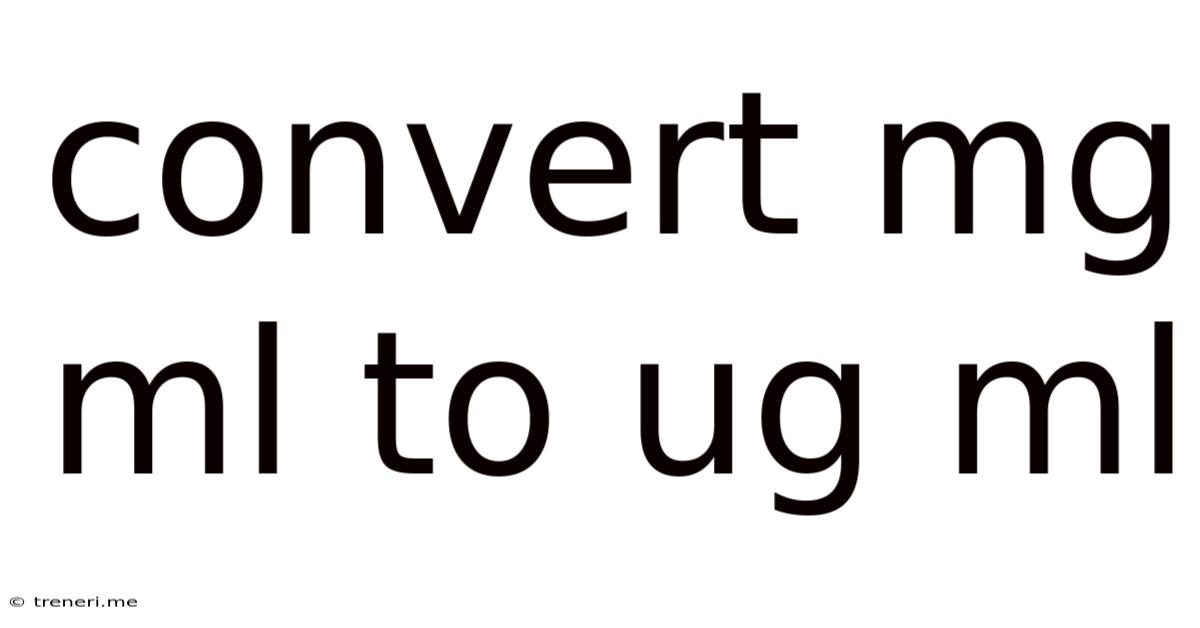Convert Mg Ml To Ug Ml
Treneri
May 10, 2025 · 5 min read

Table of Contents
Converting mg/mL to µg/mL: A Comprehensive Guide
Converting between milligrams per milliliter (mg/mL) and micrograms per milliliter (µg/mL) is a fundamental task in many scientific fields, particularly analytical chemistry, pharmacology, and toxicology. Understanding this conversion is crucial for accurate data interpretation and reporting. This comprehensive guide will walk you through the process, explaining the underlying principles and providing practical examples to solidify your understanding. We'll also delve into the importance of accurate unit conversions in research and practical applications.
Understanding the Units: mg, µg, and mL
Before diving into the conversion, let's clearly define the units involved:
- mg (milligram): A unit of mass equal to one-thousandth of a gram (1 mg = 0.001 g).
- µg (microgram): A unit of mass equal to one-millionth of a gram (1 µg = 0.000001 g) or one-thousandth of a milligram (1 µg = 0.001 mg). The Greek letter 'µ' (mu) represents 'micro'.
- mL (milliliter): A unit of volume equal to one-thousandth of a liter (1 mL = 0.001 L).
The crucial relationship here is between the mass units: 1 mg = 1000 µg. This forms the basis of our conversion.
The Conversion Factor: From mg/mL to µg/mL
The conversion from mg/mL to µg/mL involves a simple multiplication by a factor of 1000. This is because there are 1000 micrograms in one milligram. The milliliter (mL) unit remains unchanged as we are only converting the mass unit.
The formula is:
µg/mL = mg/mL * 1000
This means that to convert a concentration expressed in mg/mL to µg/mL, you simply multiply the value by 1000.
Practical Examples: Step-by-Step Conversions
Let's illustrate the conversion with a few examples:
Example 1:
A solution has a concentration of 5 mg/mL. What is its concentration in µg/mL?
Using the formula:
µg/mL = 5 mg/mL * 1000 = 5000 µg/mL
Therefore, a 5 mg/mL solution has a concentration of 5000 µg/mL.
Example 2:
A drug is administered at a dose of 0.25 mg/mL. Convert this to µg/mL.
Using the formula:
µg/mL = 0.25 mg/mL * 1000 = 250 µg/mL
The drug is administered at a dose of 250 µg/mL.
Example 3:
A sample contains 12.75 mg/mL of a particular analyte. Express this concentration in µg/mL.
Using the formula:
µg/mL = 12.75 mg/mL * 1000 = 12750 µg/mL
The concentration of the analyte is 12750 µg/mL.
Reverse Conversion: From µg/mL to mg/mL
The reverse conversion, from µg/mL to mg/mL, involves dividing the value by 1000.
The formula is:
mg/mL = µg/mL / 1000
Example 4:
A solution has a concentration of 7500 µg/mL. What is its concentration in mg/mL?
Using the formula:
mg/mL = 7500 µg/mL / 1000 = 7.5 mg/mL
The solution has a concentration of 7.5 mg/mL.
Example 5:
A sample shows a concentration of 250 µg/mL. Convert this to mg/mL.
Using the formula:
mg/mL = 250 µg/mL / 1000 = 0.25 mg/mL
The sample concentration is 0.25 mg/mL.
Importance of Accurate Unit Conversions in Scientific Research
Accurate unit conversions are paramount in scientific research for several reasons:
- Data Integrity: Incorrect conversions can lead to flawed interpretations of experimental results and potentially erroneous conclusions. This can have significant implications, especially in fields like medicine and environmental science where accurate measurements are critical.
- Reproducibility: Precise unit conversions ensure that experiments can be replicated accurately by other researchers. Inconsistencies in units can hinder the reproducibility of scientific findings.
- Data Comparability: Consistent units allow for the easy comparison of data from different sources and experiments. This facilitates meta-analysis and broader understanding of scientific phenomena.
- Avoiding Errors: Simple errors in unit conversions can have cascading effects, leading to significant inaccuracies in calculations and analyses.
Common Mistakes to Avoid
While the conversion itself is straightforward, several common mistakes can occur:
- Incorrect use of the conversion factor: Remember to multiply by 1000 when converting from mg/mL to µg/mL and divide by 1000 for the reverse conversion. Confusing these operations is a frequent error.
- Unit Misunderstandings: Ensuring a clear understanding of the units (mg, µg, and mL) is essential to avoid mistakes.
- Significant Figures: Pay close attention to significant figures throughout the calculation to maintain the accuracy of the final result.
Beyond mg/mL and µg/mL: Expanding Your Unit Conversion Skills
The principles outlined here can be extended to other unit conversions in various scientific contexts. Understanding the relationships between different prefixes (milli, micro, nano, etc.) and their corresponding numerical values is crucial for mastering unit conversions. Familiarizing yourself with conversion tables and online calculators can further enhance your skills. Practice is key to mastering unit conversions and ensuring accuracy in your scientific work.
Conclusion
Converting mg/mL to µg/mL (and vice-versa) is a crucial skill for anyone working in scientific fields. The simple multiplication or division by 1000, while seemingly straightforward, requires careful attention to detail to avoid errors. Mastering this conversion contributes to data integrity, reproducibility, and the overall accuracy of scientific research and applications. Always double-check your calculations and strive for accuracy to ensure the reliability of your results. Remember that accurate unit conversions are fundamental to the integrity of scientific work and its contribution to the advancement of knowledge. Thorough understanding and diligent practice will minimize errors and improve confidence in your scientific endeavors.
Latest Posts
Latest Posts
-
5 Divided By 3 4 In Fraction Form
May 10, 2025
-
How Old Am I If I Was Born 1996
May 10, 2025
-
How Do You Calculate The Slope Of A Ramp
May 10, 2025
-
How To Calculate Battery Watt Hours
May 10, 2025
-
506 Rounded To The Nearest Ten
May 10, 2025
Related Post
Thank you for visiting our website which covers about Convert Mg Ml To Ug Ml . We hope the information provided has been useful to you. Feel free to contact us if you have any questions or need further assistance. See you next time and don't miss to bookmark.